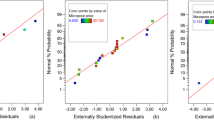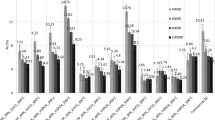Abstract
Polyaniline-poly(styrene sulfonate) (PAn-PSS) hydrogels-based powdered activated carbons (PAC) were prepared and investigated. Structural properties of PAC were characterized by nitrogen absorption–desorption and elemental analysis. Surface properties of PAC were studied by Fourier transform infrared spectroscopy, X-ray photoelectron spectroscopy, and scanning electron microscopy techniques. Activated carbon particles possessed high mesopore ratio of 54 % which can ensure the smooth entrance of the adsorbates of proper size. On the other hand, these materials were nitrogen-enriched due to the PAn-PSS precursor. Amino groups are tended to form chemical bonds with certain adsorbates which help intensify the interaction between PAC and certain adsorbates, thus promote their adsorption on PAC. The adsorption behavior of creatinine on these activated carbon particles was also studied. In comparison with the coconut shell activated carbon particles, PAC showed a better (P < 0.05, statistically) adsorption ability of 341.2 mg/g. Freundlich model was employed to describe the isothermal adsorption behavior of creatinine on PAC and the coefficient of determination (R 2) was greater than 0.98. Moreover, the study of the adsorption kinetics showed that the equilibrium condition of creatinine adsorption on PAC can be reached within 7 h and the adsorption ratio was 53.7 %. Kinetic adsorption data were well fitted according to the pseudo-second-order model, implying that it was a chemisorption process and the adsorption mechanism involved intermolecular H-bonding between adsorbent and adsorbate.








Similar content being viewed by others
References
Okur I, Ezgu F, Biberoglu G, Tumer L, Erten Y, Isitman M, Eminoglu FT, Hasanoglu A (2013) Screening for Fabry disease in patients undergoing dialysis for chronic renal failure in Turkey: identification of new case with novel mutation. Gene 527:42–47
Wu Y, Ye M, Du Z, Jing L, Surahio M, Yang L (2014) Carboxymethylation of an exopolysaccharide from Lachnum and effect of its derivatives on experimental chronic renal failure. Carbohydr Polym 114:190–195
Ali BH, Madanagopal TT, Ramkumar A, Boudaka A, Tageldin MH, Nemmar A (2014) Some physiological and histological aspects of the gastrointestinal tract in a mouse model of chronic renal failure. J Pharmacol Toxicol Methods 69:162–166
Volpe DA, Tobin GA, Tavakkoli F, Dowling TC, Light PD, Parker RJ (2014) Effect of uremic serum and uremic toxins on drug metabolism in human microsomes. Regul Toxicol Pharmacol 68:297–303
Alix PM, Guebre-Egziabher F, Soulage CO (2014) Leptin as an uremic toxin: deleterious role of leptin in chronic kidney disease. Biochimie 105:12–21
Cornelis T, van der Sande FM, Eloot S, Cardinaels E, Bekers O, Damoiseaux J, Leunissen KM, Kooman JP (2014) Acute hemodynamic response and uremic toxin removal in conventional and extended hemodialysis and hemodiafiltration: a randomized crossover study. Am J Kidney Dis 64:247–256
Adijiang A, Higuchi Y, Nishijima F, Shimizu H, Niwa T (2010) Indoxyl sulfate, a uremic toxin, promotes cell senescence in aorta of hypertensive rats. Biochem Biophys Res Commun 399:637–641
Ye C, Gong QM, Lu FP, Liang J (2007) Adsorption of uraemic toxins on carbon nanotubes. Sep Purif Technol 58:2–6
Lee CJ, Hsu ST (1990) Preparation of spherical encapsulation of activated carbons and their adsorption capacity of typical uremic toxins. J Biomed Mater Res 24:243–258
Malik DJ, Warwick GL, Mathieson I, Hoenich NA, Streat M (2005) Structured carbon haemoadsorbents for the removal of middle molecular weight toxins. Carbon 43:2317–2329
Marier JF, Lee J, Kambhampati SR, Galitz L, Vargas R, Moberly J, Salazar DE (2006) Effect of repeated oral administrations of the oral adsorbent AST-120 on serum creatinine and other markers of renal function. Am J Nephrol 26:136–141
Tang Q, Wu J, Sun H, Fan S, Hu D, Lin J (2008) Superabsorbent conducting hydrogel from poly (acrylamide-aniline) with thermo-sensitivity and release properties. Carbohyd Polym 73:473–481
Tang Q, Wu J, Sun H, Lin J, Fan S, Hu D (2008) Polyaniline/polyacrylamide conducting composite hydrogel with a porous structure. Carbohydr Polym 74:215–219
Tang Q, Lin J, Wu J, Zhang C, Hao S (2007) Two-steps synthesis of a poly(acrylate-aniline) conducting hydrogel with an interpenetrated networks structure. Carbohydr Polym 67:332–336
Tang Q, Wu J, Lin J (2008) A multifunctional hydrogel with high conductivity, pH-responsive, thermo-responsive and release properties from polyacrylate/polyaniline hybrid. Carbohydr Polym 73:315–321
Molberg M, Crespy D, Rupper P, Nüesch F, Månson JAE, Löwe C, Opris DM (2010) High breakdown field dielectric elastomer actuators using encapsulated polyaniline as high dielectric constant filler. Adv Funct Mater 20:3280–3291
Lü QF, He ZW, Zhang JY, Lin Q (2011) Fabrication of nitrogen-containing hollow carbon nanospheres by pyrolysis of self-assembled poly(aniline-co-pyrrole). J Anal Appl Pyrol 93:147–152
Trchová M, Konyushenko EN, Stejskal J, Kovářová J, Ćirić-Marjanović G (2009) The conversion of polyaniline nanotubes to nitrogen-containing carbon nanotubes and their comparison with multi-walled carbon nanotubes. Polym Degrad Stab 94:929–983
Rozlívková Z, Trchová M, Exnerová M, Stejskal J (2011) The carbonization of granular polyaniline to produce nitrogen-containing carbon. Synth Met 161:1122–1129
Dai T, Jia Y (2011) Supramolecular hydrogels of polyaniline-poly(styrene sulfonate) prepared in concentrated solutions. Polymer 52:2550–2558
Peer M, Qajar A, Rajagopalan R, Foley HC (2014) Synthesis of carbon with bimodal porosity by simultaneous polymerization of furfuryl alcohol and phloroglucinol. Microporous Mesoporous Mater 196:235–242
Den W, Lobovsky A, Iacono ST, Wu T, Tomar N, Budy SM, Long T, Hoffman WP, Smith DW Jr (2011) Poly (acrylonitrile-co-1-vinylimidazole): a new melt processable carbon fiber precursor. Polymer 52:622–628
Lu X, Jiang J, Sun K, Wang J, Zhang Y (2014) Influence of the pore structure and surface chemical properties of activated carbon on the adsorption of mercury from aqueous solutions. Mar Pollut Bull 78:69–76
Arjona AM, Soto JBP, Arean CO (1982) Analysis of nitrogen adsorption—desorption isotherms on porous metal oxides: a comparative study of several models. Stud Surf Sci Catal 10:175–186
Nguyen PTM, Do DD, Nicholson D (2013) Pore connectivity and hysteresis in gas adsorption: a simple three-pore model. Colloids Surf A 437:56–68
Palmer JC, Brennan JK, Hurley MM, Balboa A, Gubbins KE (2009) Detailed structural models for activated carbons from molecular simulation. Carbon 47:2904–2913
Grande CA, Blom R, Möller A, Möllmer J (2013) High-pressure separation of CH4/CO2 using activated carbon. Chem Eng Sci 89:10–20
Yang JB, Ling LC, Liu L, Kang FY, Huang ZH, Wu H (2002) Preparation and properties of phenolic resin-based activated carbon spheres with controlled pore size distribution. Carbon 40:911–916
Zubizarreta L, Arenillas A, Pis JJ (2008) Preparation of Ni-doped carbon nanospheres with different surface chemistry and controlled pore structure. Appl Surf Sci 254:3993–4000
Trakhtenberg S, Balkir YH, Warner JC, Bruno FF, Kumar J, Nagarajan R, Samuelson LA (2005) Photo-cross-linked immobilization of polyelectrolytes for enzymatic construction of conductive nanocomposites. J Am Chem Soc 127:9100–9104
Lu X, Jiang J, Sun K, Xie X, Hu Y (2012) Surface modification, characterization and adsorptive properties of a coconut activated carbon. Appl Surf Sci 258:8247–8252
Coleman MM, Painter PC (1995) Hydrogen bonded polymer blends. Progr Polym Sci 20:1–59
Jia Y, Jiang J, Sun K, Dai T (2012) Enhancement of capacitance performance of activated carbon—polyaniline composites by introducing methyl orange. Electrochim Acta 71:213–218
Guo Z, Wang LF, Gao Z, Zhang WW (2007) Equilibrium and kinetic studies on the adsorption of VB12 onto CMK-3. Chin Chem Lett 18:233–236
Ismail LFM, Sallam HB, Abo Farha SA, Gamal AM, Mahmoud GEA (2014) Adsorption behaviour of direct yellow 50 onto cotton fiber: equilibrium, kinetic and thermodynamic profile. Spectrochim Acta A 131:657–666
Lad JB, Makkawi YT (2014) Adsorption of dimethyl ether (DME) on zeolite molecular sieves. Chem Eng J 256:335–346
Guo Z, Zhu G, Gao B, Zhang D, Tian G, Chen Y, Zhang W, Qiu S (2005) Adsorption of vitamin B12 on ordered mesoporous carbons coated with PMMA. Carbon 43:2344–2351
Liu N, Yu LL, Sun Y (2014) Protein adsorption to poly(ethylenimine)-modified Sepharose FF. IV. Dynamic adsorption and elution behaviors. J Chromatogr A 1362:218–224
Ho YS, McKay G (1999) Pseudo-second order model for sorption processes. Process Biochem 34:451–465
Ho YS (2006) Review of second-order models for adsorption systems. J Hazard Mater 136:681–689
Ho YS, Mckya G (1999) The sorption of lead (II) ions on peat. Water Res 33:578–584
Acknowledgments
This research is financially supported by the projects in Forestry Public Benefit Research Sector (201404610) and Jilin Provincial Key Laboratory of Wooden Materials Science and Engineering Open Fund of China.
Author information
Authors and Affiliations
Corresponding author
Rights and permissions
About this article
Cite this article
Jia, Y., Li, X., Jiang, J. et al. Adsorption of creatinine on polyaniline-poly(styrene sulfonate) hydrogels based activated carbon particles. Iran Polym J 24, 775–781 (2015). https://doi.org/10.1007/s13726-015-0366-8
Received:
Accepted:
Published:
Issue Date:
DOI: https://doi.org/10.1007/s13726-015-0366-8




